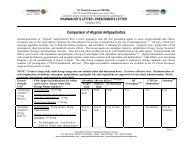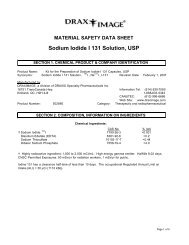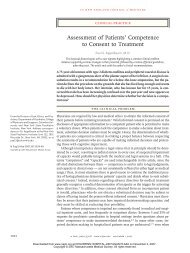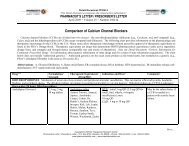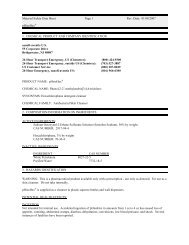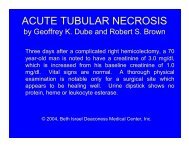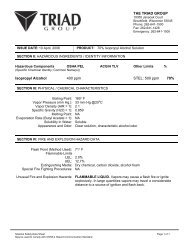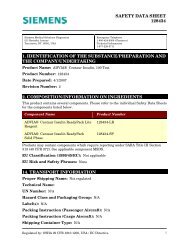The Nephritic Syndrome.3.ppt [Read-Only]
The Nephritic Syndrome.3.ppt [Read-Only]
The Nephritic Syndrome.3.ppt [Read-Only]
You also want an ePaper? Increase the reach of your titles
YUMPU automatically turns print PDFs into web optimized ePapers that Google loves.
THE NEPHRITIC SYNDROME<br />
by Geoffrey K. Dube and Robert S. Brown<br />
A 21 year-old woman presents with tea-colored urine<br />
three weeks after being evaluated for a sore throat.<br />
Physical examination is notable for a blood pressure<br />
of 170/100 and 3+ pitting edema. Serum creatinine<br />
is 2.1 mg/dl. Urine dipstick demonstrates 2+ protein,<br />
large heme and large leukocyte esterase.<br />
© 2004, Beth Israel Deaconess Medical Center, Inc.
A 21 year-old woman presents with tea-colored urine three weeks after<br />
being evaluated for a sore throat. Physical examination is notable for a<br />
blood pressure of 170/100 and 3+ pitting edema. Serum creatinine is 2.1<br />
mg/dl. Urine dipstick demonstrates 2+ protein, large heme and large<br />
leukocyte esterase.<br />
Based on the results of the urine dipstick, which of<br />
the following diagnoses is most unlikely?<br />
a. <strong>The</strong> nephrotic syndrome.<br />
b. <strong>The</strong> nephritic syndrome.<br />
c. A combined nephrotic and nephritic syndrome.<br />
d. Acute tubular necrosis.
In this case, the urine dipstick suggests the presence<br />
of erythrocytes and leukocytes in the urine, as well as<br />
proteinuria that probably does not reach the nephrotic<br />
range. <strong>The</strong> urine dipstick measures mainly the<br />
concentration of albumin in the urine, and thus, is<br />
dependent on the total amount of protein in the urine<br />
and the total urine volume. Thus, a reading of 4+<br />
protein by dipstick does not guarantee the presence<br />
of nephrotic-range proteinuria (if oliguria is present)<br />
and a reading of 2+ does not rule out nephrotic-range<br />
proteinuria (if urine volume is large). <strong>The</strong> findings in<br />
this case are most consistent with a nephritic urine,<br />
although they may also be seen in other conditions<br />
such as acute pyelonephritis or acute tubular<br />
necrosis.
<strong>The</strong> nephritic syndrome is characterized by the<br />
appearance, at times sudden, of hematuria associated<br />
with proteinuria. <strong>The</strong> nephritic syndrome may also be<br />
associated with an elevated serum creatinine, oliguria<br />
and hypertension. In the nephritic syndrome, breaks in<br />
the glomerular basement membrane, mainly due to<br />
immunologic phenomena, allow erythrocytes and<br />
leukocytes to enter the urine. Damage to the glomerular<br />
basement membrane also accounts for the presence of<br />
abnormal amounts of protein in the urine.
In contrast to nephritic urine, nephrotic urine<br />
typically contains at most a few erythrocytes<br />
and leukocytes. <strong>The</strong> dipstick will often be<br />
negative or show only trace amounts of heme<br />
pigment and leukocyte esterase. <strong>The</strong> dipstick<br />
will usually read 4+ protein, although a large<br />
urine volume may cause the dipstick to be<br />
less strongly positive.
Occasionally, the nephrotic syndrome and the<br />
nephritic syndrome can coexist in a patient.<br />
Examples include lupus nephritis, Henoch-<br />
Shonlein purpura, membranoproliferative<br />
glomerulonephritis and acute renal failure due<br />
to non-steroidal anti-inflammatory drugs. In<br />
these cases, the dipstick usually will be<br />
strongly positive for heme pigment, leukocyte<br />
esterase, and protein.
In acute tubular necrosis, large amounts of<br />
hematuria, pyuria and proteinuria are typically<br />
absent unless there is concurrent damage to<br />
the glomeruli or interstitium. However, in<br />
patients with preexisting intrinsic renal<br />
disease, the dipstick may be positive for<br />
heme, leukocyte esterase and/or protein even<br />
in the absence of acute glomerular or<br />
interstitial disease.
<strong>The</strong> urine sediment from the patient in the case is<br />
shown above. What is demonstrated?<br />
a. Acanthocytes and dysmorphic erythrocytes<br />
b. Lipid droplets<br />
c. Leukocytes<br />
d. Renal tubular epithelial cells
In hematuria of glomerular origin, most erythrocytes have a<br />
distorted appearance and many are smaller than usually. <strong>The</strong>y<br />
are referred to as dysmorphic erythrocytes. A subtype of<br />
dysmorphic erythrocytes is referred to as acanthocytes.<br />
Acanthocytes (arrow) are ring-shaped erythrocytes with one or<br />
more vesicle-like protrusions. <strong>The</strong> etiology of dysmorphic<br />
erythrocytes and acanthocytes is thought to be related to<br />
membrane damage that occurs as the erythrocyte passes<br />
through breaks in the glomerular basement membrane.
Acanthocytes (above, left) should be distinguished from<br />
crenated red cells (above, right). Crenated erythrocytes form in<br />
highly concentrated urine. In urine with a high osmolality, water<br />
will pass out of the erythrocyte by osmosis, resulting in a<br />
reduced cell diameter. Crenated erythrocytes have<br />
characteristic spicules, as shown in the slide on the right. In<br />
urine with a low osmolality, water will pass into the erythrocyte<br />
by osmosis, resulting in an increased cell diameter. If enough<br />
water enters the erythrocyte, the cell can lyse.
Lipid droplets (above) can be distinguished from<br />
erythrocytes by their variable size and their color. Lipid<br />
droplets are not found in nephritic urine unless there is a<br />
concurrent nephrotic process, as can occur in<br />
membranoproliferative glomerulonephritis and in some<br />
types of lupus nephritis.
Leukocytes can be present in variable amounts in<br />
nephritic sediment. Leukocytes are granular cells which<br />
are larger than erythrocytes and contain a nucleus that<br />
may be difficult to define. <strong>The</strong> slide on the right shows<br />
both leukocytes (yellow arrows) and normal erythrocytes.<br />
<strong>The</strong> slide on the left shows dysmorphic erythrocytes and<br />
acanthocytes for comparison.
Renal tubular epithelial cells (above right, contained within a<br />
cast) are typically seen in conditions which primarily involve<br />
the tubules, such as ATN, interstitial nephritis and acute<br />
allograft rejection. If the inflammation from acute<br />
glomerulonephritis extends to the tubules, renal tubule<br />
epithelial (RTE) cells can occasionally be seen in a nephritic<br />
sediment. In some nephrotic sediments, RTE cells can be<br />
seen due to tubular cell sloughing associated with damage<br />
caused by heavy proteinuria and/or lipid droplet reabsorption.
Examination of our patient’s sediment also showed the two<br />
formed elements shown above. What do they represent?<br />
a. Erythrocyte casts<br />
b. Leukocyte casts<br />
c. Hemoglobin casts<br />
d. Granular casts
Erythrocyte casts are formed in the tubule lumen as<br />
erythrocytes complex with Tamm-Horsfall mucoprotein.<br />
Erythrocyte casts are a marker of bleeding within the nephrons<br />
of the kidney. <strong>The</strong>y are most often seen in glomerulonephritis,<br />
although they can also be seen in acute interstitial nephritis and<br />
renal vasculitis. Although erythrocyte casts are an important<br />
sign of acute glomerulonephritis, they are only variably present<br />
in the nephritic sediment.
Leukocyte casts, as seen in the slide on the left, are seen in<br />
upper urinary tract bacterial infection, although they can also<br />
be seen with non-bacterial renal inflammation due to acute<br />
interstitial nephritis and some forms of acute<br />
glomerulonephritis. <strong>The</strong> slide on the right shows an<br />
erythrocyte cast. Erythrocytes are smaller than leukocytes,<br />
have a non-granular cytoplasm, and have no nucleus. In<br />
contrast, leukocytes have a granular cytoplasm and have a<br />
nucleus, although the nucleus may sometimes be difficult to<br />
appreciate in an unstained sediment.
Hemoglobin casts are pigmented cellular casts that develop in<br />
the presence of degenerated erythrocytes within the cast<br />
matrix. <strong>The</strong>y are typically brown in color and have a granular<br />
appearance. Focusing up and down on the microscope may<br />
reveal the presence of degenerated erythrocytes within the<br />
hemoglobin cast. Rarely, hemoglobin casts develop in cases of<br />
intravascular hemolysis. In these cases, the dipstick will be<br />
positive for heme but there will be no evidence of microscopic<br />
hematuria, and degenerated erythrocytes will not be present<br />
within the hemoglobin cast.
Another example of a pigmented cast is a bilirubin<br />
cast. Bilirubin in the urine can stain any type of cast,<br />
causing the cast to take on the typical yellow<br />
appearance of bilirubin.
Granular casts, like the one shown above, are a non-specific<br />
finding which can be seen in numerous kidney disorders,<br />
including ones which present with the nephritic syndrome. It is<br />
thought that the granules are composed of degenerating cells<br />
and filtered proteins that have subsequently aggregated within<br />
the renal tubules. Although granular casts are a non-specific<br />
finding, their presence in the sediment suggests the presence<br />
of intrinsic renal disease.


![The Nephritic Syndrome.3.ppt [Read-Only]](https://img.yumpu.com/24285503/1/500x640/the-nephritic-syndrome3ppt-read-only.jpg)
